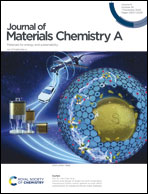Plasmon-stimulated biophotovoltaic cells based on thylakoid–AuNR conjugates†
Abstract
Despite the high quantum efficiency of solar energy conversion by photosynthesis, practical development of photosynthetic solar energy has been limited so far. One of the main challenges is the relatively poor absorption of photons by photosystems due to narrow absorption spectra, reflection, and respiration. Although most studies focused on increasing the harvesting of photosynthetic electrons (PEs), engineering photon absorption in photosynthesis is another important pathway to pursue for enhancement of photosynthetic solar energy harvesting. Here, plasmonic resonance energy transfer (PRET) from plasmonic nanoparticles to thylakoid membranes (TMs) is proposed to stimulate photosynthesis and increase production of PEs. Gold nanorods (AuNRs), which have a plasmon resonance peak close to 680 nm, are selected to increase the production of high energy PEs by PRET. With AuNR conjugation to spinach TMs, light-triggered PE currents increase to the magnitude 4 fold larger than the currents without the plasmonic AuNRs. Biophotovoltaic (BPV) cells were prepared with the plasmon-enhanced spinach TMs, and they were connected in series and with a capacitor for charge accumulation. The spinach BPVs were charged to achieve high OCP enough to power an LED lamp, demonstrating the feasibility to operate low-power electronics.



 Please wait while we load your content...
Please wait while we load your content...